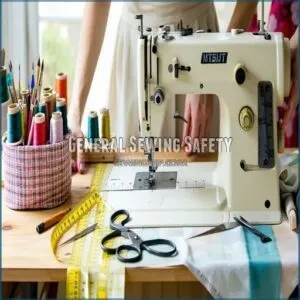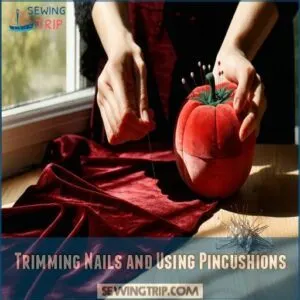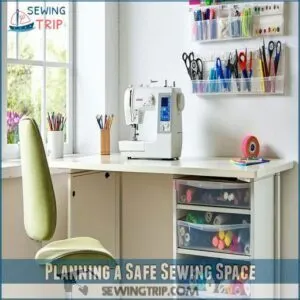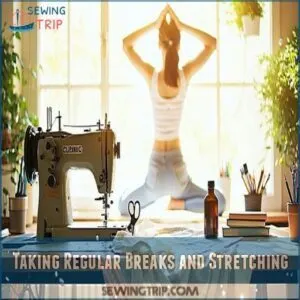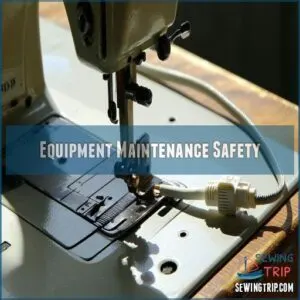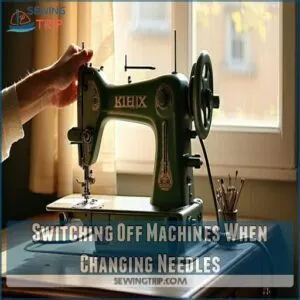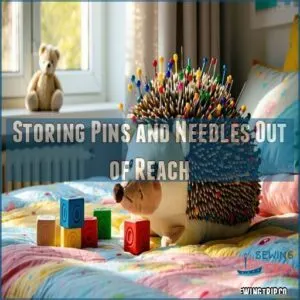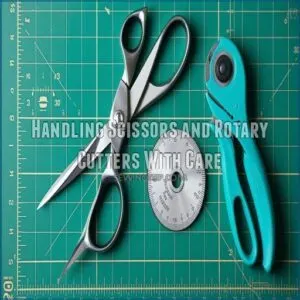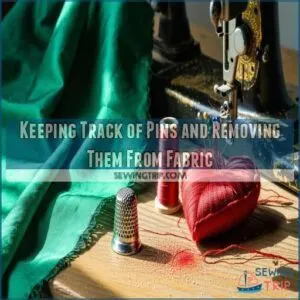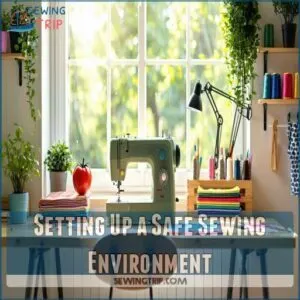This site is supported by our readers. We may earn a commission, at no cost to you, if you purchase through links.
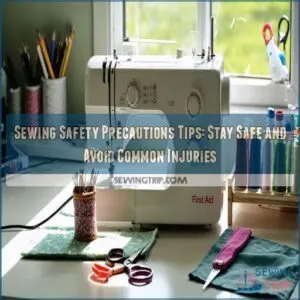
Unplug your machine before making adjustments and check electrical cords regularly to prevent shock surprises. Create a no-fingers zone around moving needles.
Take breaks to prevent eye strain and back tension. Organize your workspace strategically, routing cords along walls and separating cutting, sewing, and ironing stations.
Remember, a clean, well-maintained sewing area isn’t just smart—it’s your first line of defense against potential crafting calamities. A clean, well-maintained sewing area is essential for safety.
Table Of Contents
Key Takeaways
- You’ll want to treat your sharp sewing tools like royalty, storing needles, scissors, and pins securely out of children’s and pets’ reach to prevent accidental injuries.
- Always unplug your sewing machine before making adjustments, regularly check electrical cords, and use surge protectors to avoid potential electrical hazards and shock risks.
- Create a strategic workspace with separate stations for cutting, sewing, and ironing, ensuring proper lighting, ergonomic furniture, and clear pathways to minimize accidents.
- Take regular breaks every 30-45 minutes to prevent eye strain, back tension, and maintain proper posture while keeping your sewing area clean, organized, and well-maintained.
General Sewing Safety
When you’re sewing, it’s easy to forget that sharp tools and fast-moving machines can pose risks.
Staying alert and following basic safety rules can keep your projects fun and accident-free.
Handling Sharp Objects
Sharp objects like scissors and needles need respect! Practice sewing needle safety by storing them out of reach from kids and pets.
Pin cushion alternatives, like wrist pin holders, keep pins handy and reduce sewing room hazards.
For rotary cutter safety, always use blade covers. Cutting tool maintenance is essential—keep blades sharp but handle them carefully to avoid mishaps.
Avoiding Electrical Hazards
In the area of electrical safety, don’t overlook cord safety tips like keeping wires away from water or heat.
Always check outlets to avoid overloads and unplug appliances during adjustment or cleaning.
Use a power strip with surge protection for added safety.
Maintaining sewing machine safety is essential for preventing accidents.
Regular sewing machine maintenance and voltage checking can also help with electric shock prevention.
Preventing Accidents With Hot Surfaces
An unattended iron can quickly become your worst enemy.
Practice ironing safety by always unplugging it after use and letting it cool completely.
Use a thermal guard or sturdy ironing board for surface protection to prevent accidental burns.
Teach kids heat safety, and never ignore steamers—they’re sneaky burn hazards, too.
Sewing fire safety starts with vigilance around hot surfaces.
Importance of Proper Needle Maintenance
Neglecting needle maintenance leads to trouble—needle breakage, uneven thread tension, or even fabric damage.
Check for dullness or bends before every project; it guarantees proper needle sharpness and smooth sewing.
Protect needles by using cases or guards when not in use.
Understanding sewing safety is vital for preventing accidents and ensuring a safe stitching experience.
Slow down your sewing speed and always follow needle safety tips.
Needle awareness prevents accidents and guarantees safe stitching.
Safe Sewing Practices
You’ll want to transform your sewing space into a sanctuary of safety, where every stitch and movement is carefully planned to prevent potential mishaps.
By focusing on smart practices like using pincushions, trimming your nails, and taking regular breaks, you’ll create an environment that protects you from common sewing-related injuries and keeps your crafting experience enjoyable.
Trimming Nails and Using Pincushions
Your hands are your most valuable sewing companions, so protect them like gold! Maintaining hand hygiene and nail care is essential for fabric protection and needle safety.
Here’s how to keep your digits in top shape:
- Trim nails short to prevent snagging threads
- Use a wrist-hugging pincushion for easy pin storage
- Keep hands clean to avoid fabric stains
- Practice sewing hygiene for smooth, snag-free projects
Supervising Children and Pets
Create designated sewing zones that bar pets and little ones from wandering into danger. After trimming those nails, keep sharp sewing tools out of curious paws and tiny hands.
Child supervision is key – teach young children about safe interactions with sewing equipment, and always keep scissors, pins, and needles locked away from playful fingers and furry friends.
Planning a Safe Sewing Space
A sewing enthusiast’s workspace can be a sanctuary of creativity or a minefield of potential mishaps. Creating a safe, organized sewing space requires strategic planning:
- Designate a dedicated sewing area away from high-traffic zones
- Invest in ergonomic furniture that supports proper posture
- Provide ample lighting to prevent eye strain and accidents
- Implement childproof storage solutions for sharp tools
Taking Regular Breaks and Stretching
Sewing marathon sessions can turn your creative haven into a pain-inducing battlefield.
To maintain a safe environment, following sewing safety guidelines is important for injury prevention. Set break frequency reminders every 30-45 minutes to combat eye strain and prevent back and shoulder problems.
Stretch out those tense muscles, check your sewing posture, and take quick micro-breaks. Your body will thank you, and your sewing enjoyment will soar.
Equipment Maintenance Safety
Regularly checking cords, plugs, and electrical connections for any signs of wear or damage keeps your sewing equipment running smoothly and safely.
This preventative maintenance will prevent potential electrical hazards and guarantee your sewing space remains a secure environment for creative projects.
Unplugging Appliances for Adjustments
For safe maintenance, unplug your sewing machine before making any adjustments or repairs.
Power cord safety is crucial; unplugging the machine prevents unexpected shocks. This simple step protects you and allows for worry-free tinkering. Your hands will thank you for avoiding electrical surprises.
Checking Cords and Plugs for Damage
After years of crafting, you know electrical cord safety isn’t just a technicality—it’s your workshop’s lifeline.
Regularly inspect every plug and cord for fraying, discoloration, or exposed wiring that could spark trouble.
Check grounding pins, look for bent prongs, and replace damaged cords immediately.
Your vigilance prevents short circuits and keeps your creative space shock-free and secure.
Avoiding Overloaded Outlets and Electrical Fires
During your sewing projects, be mindful of outlet capacity to prevent electrical fires.
Don’t overload power strips with multiple high-wattage sewing appliances that can trigger short circuits. Check the total wattage of your equipment and use heavy-duty extension cords rated for your machines.
A little electrical safety awareness keeps your creative space spark-free and your crafting dreams burning bright.
Using Voltage Transformers and Surge Protectors
In the midst of your sewing sanctuary, voltage transformers and surge protectors become your electrical guardians.
They’ll shield your precious machines from power fluctuations and unexpected electrical hiccups. Understanding sewing safety measures is vital to prevent accidents and maintain a safe working environment.
Choose a heavy-duty extension cord with surge protection rated for your sewing appliances’ watts. This small investment prevents potential equipment damage and keeps your creative space safe from unexpected electrical mishaps.
Handling Sharp Objects Safely
In the context of sewing, sharp objects like needles, pins, and scissors can quickly turn from helpful tools to potential hazards if you’re not careful.
You’ll want to handle these sharp companions with respect, keeping them organized, stored safely, and always out of reach of curious children and pets.
Switching Off Machines When Changing Needles
After ensuring your sewing machine is in top shape, let’s tackle needle replacement safely.
Power down your machine before swapping needles – it’s your first line of defense against unexpected starts.
Here’s how to keep those fingers safe:
- Unplug the machine completely
- Move your hand away from the power switch
- Double-check the machine is off before touching the needle
This process ensures your safety while working with your sewing machine.
Storing Pins and Needles Out of Reach
Once you’ve switched off your machine, keep those sharp companions under lock and key.
Invest in creative pincushion designs that shield your space from wandering fingers. A wrist-hugging pincushion or secure container isn’t just smart—it’s your first line of defense in pin and needle safety.
Childproofing your sewing area prevents unexpected pokes and potential mishaps.
Handling Scissors and Rotary Cutters With Care
Pins safely stored away? Now, let’s discuss scissors and rotary cutter safety. Keep sharp cutting tools out of kids’ reach, always pointing blades away from your body.
Grip scissors by their handles, never run with them, and store them in a designated spot. Understanding safety scissors features is important for preventing accidents and a safe sewing experience.
Rotary cutters demand respect – retract the blade when not in use to prevent accidental nicks.
Keeping Track of Pins and Removing Them From Fabric
Secure your sewing sanctuary by mastering pin management with magnetic pin holders and strategic organization. Using a magnetic pin holder can greatly improve your workflow.
Develop a habit of removing pins systematically, using a designated container or pincushion.
Keep your fabric pin-free before sewing to prevent needle damage and potential injuries. Stay alert and cautious, treating each pin as a potential safety risk in your creative space.
Setting Up a Safe Sewing Environment
Your sewing space isn’t just a room—it’s your creative sanctuary that demands careful planning and attention to safety.
By thoughtfully organizing your workspace and minimizing potential hazards, you’ll create an environment where creativity can flourish without compromising your well-being.
Preventing Tripping Hazards With Cords
Keep your workspace safe with these smart strategies: After carefully handling sharp objects, let’s untangle the cord chaos in your sewing space. Don’t let electrical cords become a tripping trap!
- Route cords along walls, not across walkways
- Use cable management clips or ties
- Consider wireless sewing machine options
- Create clear, designated pathways around your workspace
Keep those cords corralled and your sewing sanctuary accident-free!
Establishing a No Fingers Zone Around Needles
Your injury prevention strategy starts with razor-sharp awareness and respect for those sharp sewing needles.
When those electrical cords are neatly tucked away, you’ll want to create a rock-solid needle safety zone.
Draw an imaginary line around your sewing machine’s needle, treating it like a no-touch boundary. Keep fingers far from the moving parts, using hand positioning training to maintain a safe distance.
Teaching Children to Sew Slowly and Patiently
Teaching children to sew requires a gentle approach that transforms potential frustration into a fun learning experience. Focus on guiding your little crafters with patience and care.
- Start with simple, short sewing sessions
- Demonstrate slow, controlled needle movements
- Use child-friendly, colorful materials
- Praise gradual progress and mindful stitching
- Emphasize safety over speed
By following sewing safety tips, you can create a secure environment that fosters creativity and skill-building.
Your child’s sewing pace will naturally improve with consistent, supportive guidance and kid-friendly sewing safety tips.
Separating Tables for Sewing, Cutting, and Ironing
After guiding kids through careful sewing practices, let’s optimize your workspace.
Create distinct stations for sewing, cutting, and ironing to boost workflow efficiency and sewing room safety. Separate tables prevent cross-contamination of materials and minimize accidents.
A well-planned safe sewing setup is essential for a productive workspace. By establishing clear safety zones and task-specific areas, you’ll transform your sewing space into a streamlined, organized sanctuary that keeps creativity and caution in perfect harmony.
Frequently Asked Questions (FAQs)
What Safety Measures Should I Take When Cutting Fabric?
Protect your work surface with a self-healing cutting mat. Keep your cutting area well-lit and clutter-free.
Always use sharp, dedicated fabric scissors to prevent fraying. Watch your fingers and cut away from your body to avoid accidents.
How Often Should I Service My Sewing Machine?
Your sewing machine’s a ticking time bomb of potential breakdowns!
Service it professionally every 1-2 years or annually if you’re a heavy user.
Checking tension, cleaning lint, and lubricating moving parts to prevent unexpected malfunctions.
What Should I Do to Avoid Injury When Using a Sewing Machine?
Stay focused and alert while sewing to dodge potential accidents.
Keep fingers clear of the needle and handle sharp tools carefully.
Maintain a well-lit workspace, use proper posture, and secure loose clothing. Take breaks to prevent fatigue.
How Should I Store My Cutting Tools Safely?
Sharpen your safety skills like a pro!
Store scissors and rotary cutters in protective cases or wall-mounted holders.
Always return blades to designated spots, away from curious hands and edges pointing down to prevent accidental cuts.
Is It Safe to Allow Children to Be Around Sewing Equipment?
Children can be around sewing equipment when closely supervised.
Teach them safety rules, establish clear boundaries, and create a "no fingers" zone near needles.
Always prioritize adult guidance and patient instruction to prevent accidents.
What are the safety precautions in sewing?
Like threading a needle through life’s fabric, you’ll want to stay sharp and cautious.
Always unplug machines before adjusting. Use sharp tools carefully.
Keep workspace organized.
Wear safety glasses. Supervise children near sewing equipment.
What are 10 safety precautions?
Keep sharp objects away from kids.
Unplug machines before adjusting them. Check equipment regularly.
Use a pin cushion. Maintain good lighting. Organize workspace.
Wear fitted clothing. Learn proper technique.
Never sew when tired or distracted. Take breaks.
What are common sewing hazards?
Sharp needles, flying pins, tangled threads – watch out!
You’ll face electrical risks, potential burns from irons, and injuries from scissors.
Stay alert, organize your space, and protect yourself from sewing’s hidden dangers.
How can you prevent accident in sewing?
Stay alert and organized when sewing.
Unplug machines between uses and store sharp tools safely. Keep your workspace tidy.
Wear close-fitting clothes and use proper lighting. Take breaks to prevent accidents and maintain focus.
How do I choose the right sewing machine needle?
Match your needle to fabric weight and type.
Choose a universal 80/12 for quilting cotton, a smaller 70/10 for delicate fabrics, and a stronger 90/14 for denim.
Consider needle point – sharp for woven, ballpoint for knits.
Conclusion
Transform potential risks into creative harmony by following sewing safety precautions tips. You’ll protect yourself and your craft when your sewing room becomes a safety symphony.
Remember to stay vigilant, keep sharp tools secured, and maintain your equipment. Create a workspace that nurtures both creativity and caution.
Your mindful approach guarantees that every stitch isn’t just beautiful, but safe—turning potential hazards into a seamless crafting experience. This ensures your sewing safety.

